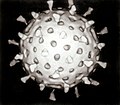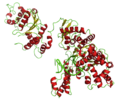loop-mediated isothermal amplification (LAMP). Virtually all nucleic acid amplification methods and detection technologies use the specificity of Watson-Crick...
11 KB (1,417 words) - 20:39, 20 July 2024
NASBA (molecular biology) (redirect from Nucleic acid sequence-based amplification)
Nucleic acid sequence-based amplification, commonly referred to as NASBA, is a method in molecular biology which is used to produce multiple copies of...
13 KB (1,634 words) - 11:47, 2 November 2024
A nucleic acid sequence is a succession of bases within the nucleotides forming alleles within a DNA (using GACT) or RNA (GACU) molecule. This succession...
22 KB (2,409 words) - 03:21, 27 November 2024
Polymerase chain reaction (redirect from Nucleic Acid Amplification)
contain humic acids may inhibit PCR amplification and lead to inaccurate results.[citation needed] Allele-specific PCR or The amplification refractory mutation...
89 KB (11,135 words) - 14:28, 3 January 2025
diseases. LAMP is an isothermal nucleic acid amplification technique. In contrast to the polymerase chain reaction (PCR) technology, in which the reaction is...
27 KB (3,191 words) - 17:59, 4 December 2024
Peptide nucleic acid (PNA) is an artificially synthesized polymer similar to DNA or RNA. Synthetic peptide nucleic acid oligomers have been used in recent...
15 KB (1,832 words) - 00:26, 22 October 2024
Nucleic acid thermodynamics is the study of how temperature affects the nucleic acid structure of double-stranded DNA (dsDNA). The melting temperature...
24 KB (2,923 words) - 19:52, 31 October 2024
Transcription-mediated amplification (TMA) is an isothermal (performed at constant temperature), single-tube nucleic acid amplification system utilizing two...
2 KB (292 words) - 19:57, 2 November 2024
of the target DNA itself, and the amplification of the signal is linear, in contrast to the exponential amplification of the target DNA in PCR. CPT uses...
8 KB (938 words) - 20:51, 3 December 2023
denaturation of double stranded DNA thereby including isothermal nucleic acid amplification. In vivo, DNA is replicated by DNA polymerases with various accessory...
6 KB (741 words) - 21:52, 19 October 2024
Viral load (section Nucleic acid-based tests (NATs))
material for amplification can be used to divide these molecular methods into three groups: Target amplification which uses the nucleic acid itself. Just...
9 KB (1,138 words) - 01:04, 4 March 2024
1155/2012/831292. PMC 3359676. PMID 22666577. "CDC |TB | ...the Uses of Nucleic Acid Amplification Tests for the Diagnosis of TB: Background". www.cdc.gov. Archived...
14 KB (1,286 words) - 14:14, 24 August 2024
Threose nucleic acid (TNA) is an artificial genetic polymer in which the natural five-carbon ribose sugar found in RNA has been replaced by an unnatural...
10 KB (1,216 words) - 21:06, 26 December 2024
Reverse transcription loop-mediated isothermal amplification (RT-LAMP) is a one step nucleic acid amplification method to multiply specific sequences of RNA...
15 KB (1,765 words) - 01:04, 18 June 2024
be used. One way to classify tests is by whether it is a nucleic acid test or non-nucleic acid test. Variation in cost and the time it takes to get a result...
31 KB (3,065 words) - 13:35, 14 October 2024
(11 November 1995). "AFLP: a new technique for DNA fingerprinting". Nucleic Acids Research. 23 (21): 4407–4414. doi:10.1093/nar/23.21.4407. ISSN 0305-1048...
7 KB (754 words) - 03:50, 30 December 2024
DNA sequencing (redirect from Sequencing technology)
process of determining the nucleic acid sequence – the order of nucleotides in DNA. It includes any method or technology that is used to determine the...
130 KB (14,899 words) - 08:39, 27 December 2024
Solid-phase reversible immobilization (category Nucleic acids)
of purifying nucleic acids from solution. It uses silica- or carboxyl-coated paramagnetic beads, which reversibly bind to nucleic acids in the presence...
3 KB (355 words) - 16:17, 10 December 2024
DNA microarray (redirect from Gene chip technology)
targets to determine relative abundance of nucleic acid sequences in the target. The original nucleic acid arrays were macro arrays approximately 9 cm...
54 KB (5,400 words) - 06:08, 28 October 2024
performing amplification of nucleic acid with two primers bound to a single solid support", published 1997-06-24, assigned to Mosaic Technologies Inc. and...
30 KB (3,056 words) - 12:04, 2 December 2024
small DNA or RNA fragments generated directly from the target nucleic acid. The amplification products can be detected by a variety of standard methods,...
5 KB (400 words) - 02:17, 7 January 2024
David Edward Birch, Walter Joseph Laird, Michael Anthony Zoccoli: Nucleic acid amplification using a reversibly inactivated thermostable enzyme. United States...
41 KB (5,164 words) - 18:26, 29 November 2024
GelRed is an intercalating nucleic acid stain used in molecular genetics for agarose gel DNA electrophoresis. GelRed structurally consists of two ethidium...
4 KB (223 words) - 11:00, 28 December 2024
(October 2000). "Solid phase DNA amplification: characterisation of primer attachment and amplification mechanisms". Nucleic Acids Res. 28 (20): 87e–87. doi:10...
2 KB (300 words) - 17:15, 8 June 2024
quantify nucleic acids by amplifying a nucleic acid molecule with the enzyme DNA polymerase. Conventional PCR is based on the theory that amplification is exponential...
69 KB (7,351 words) - 04:46, 30 October 2024
Variants of PCR (redirect from Isothermal amplification)
amplification include whole genome amplification (WGA), Nucleic acid sequence-based amplification (NASBA), and transcription-mediated amplification (TMA)...
32 KB (4,102 words) - 05:25, 7 February 2024
be enough to ensure that non-specific amplification does not occur. Another chemical modification of nucleic acid is through the heat-reversible covalent...
22 KB (2,750 words) - 14:49, 30 April 2023
loop-mediated isothermal amplification (LAMP) assay for research use. This assay can be used to test for the presence of virus through nucleic acid detection, returning...
23 KB (2,213 words) - 20:53, 17 September 2024
through reverse transcription, followed by PCR amplification of the cDNA copies (see RT-PCR). The amplified cDNA copies are then sequenced and, if long enough...
8 KB (1,025 words) - 07:12, 11 March 2023
Aminoallyl nucleotide (category Nucleic acids)
aminoallyl labeling is NASBA ( Nucleic Acid Sequence Based Amplification), a highly sensitive technique for amplifying RNA. In this specific case, the...
13 KB (1,413 words) - 15:01, 8 January 2024












